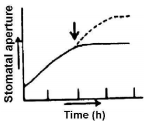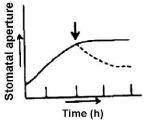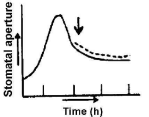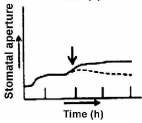 Multiple Choice Questions
Multiple Choice QuestionsWhich one of the following metabolites moves from mitochondria to peroxisome during the operation of the C2 oxidative photosynthetic cycle?
Glycerate
Glycolate
Glycine
Serine
Stomata from detached epidermis of common dayflower (Commelina communis) were treated with saturating photon fluxes of red light. In a parallel treatment, stomata treated with red light were also illuminated with blue light (indicated by arrow). From the graphs shown below, select the correct pattern of stomata opening (solid lines and dotted lines represent stomatal aperture under red and blue lights, respectively). A. B. C. D.




Following are certain statements regarding Rubisco, the predominant protein in plant leaves that catalyzes the initial reaction of the Calvin-Benson cycle.
(a) During the oxygenase activity of Rubisco, O2 is used as substrate to produce three carbon molecule, 3-phosphoglycerate and two-carbon molecule, 2-phosphoglycolate.
(b) In red and brown algae, the large subunit of Rubisco is localized in the chloroplast while small subunit is localized in the nucleus.
(c) The bound sugar phosphates in Rubisco are specifically removed by an ATP dependent enzyme, Rubisco activase.
(d) The active form of Rubisco catalyzes carboxylation or oxygenation reactions in five steps.
Which one of the following combinations of above statements is correct?
(a), (b) and (c)
(a), (b) and (d)
(b), (c) and (d)
(a), (c) and (d)
Given below are certain statements regarding plant-pathogen interactions:
(a) The pattern recognition receptor (PRR), upon perceiving pathogen or microbe associated patterns (PAPMs/MAMPs), activates plant defenses resulting in pattern triggered immunity (PTI).
(b) AvrPto is a resistance gene in tomato that acts against pathogenic attack by the bacterium Pseudomonas syringae pv. tomato.
(c) The effector molecules produced by pathogen is recognized by resistance (R) gene present in plants resulting into a defense strategy known as effector triggered immunity (ETI).
(d) Defense mechanisms triggered in plants during PTI are usually stronger than those during ETI.
Which one of the following combinations of above statements is correct?
(a) and (b)
(c) and (d)
(a) and (c)
(b) and (d)
The table given below represents the types of intercellular transport in “Column I” in land plants and their transport pathways in “Column II”.
| Column I | Column II |
| (a) Apoplastic | (i) Via interconnecting plasmodesmata |
| (b) Symplastic | (ii) Via the water filled spaces of the cell wall matrices and lumen of xylem tracheary element. |
| (c) Transcellular transport | (iii) Via the vacuole across the tonoplast followed by exist across the plasma membrane before regaining entry to the adjacent cell through the plasma membrane |
Which one of the following combinations matches column I correctly with column II.
| (a) | (b) | (c) |
| (i) | (ii) | (iii) |
| (a) | (b) | (c) |
| (ii) | (i) | (iii) |
| (a) | (b) | (c) |
| (iii) | (ii) | (i) |
| (a) | (b) | (c) |
| (i) | (iii) | (ii) |
The different segments of renal tuble (column A) and the mechanism of Na+ transport in the apical membrane of tubular cell (column B) are tabulated below:
| Column A | Column B |
| (a) Proximal Tubule | (i) Na+-Cl- symporter |
| (b) Thick ascending loop of henle | (ii) Na+- selective channel (ENaC) |
| (c) Early distal tubule | (iii) Na+- glucose symporter |
| (d) Late distal tubule and collecting duct | (iv) 1 Na+- 1 K+-2 Cl- symporter |
Select the option with the correct matches:
| (a) | (b) | (c) | (d) |
| (iii) | (iv) | (i) | (ii) |
| (a) | (b) | (c) | (d) |
| (iv) | (iii) | (ii) | (i) |
| (a) | (b) | (c) | (d) |
| (i) | (ii) | (iii) | (iv) |
| (a) | (b) | (c) | (d) |
| (ii) | (i) | (iv) | (iii) |
In order to surive in a non-aquatic environment, plants acquired several adaptations with specialized function. Given below is a list of features/characteristic (column A) and their potential role (column B)
| Column A | Column B |
| (a) Waxy cuticle | (i) Mechanical support |
| (b) Thickened or lignified cell wall | (iii) Protection against excess light |
| (c) Homoiohydry | (iii) Restrict water loss |
| (d) Pigmentation | (iv) Vascular system |
Which one of the following option respresents a correct match between the adaptions and their function.
| (a) | (b) | (c) | (d) |
| (iv) | (ii) | (i) | (iii) |
| (a) | (b) | (c) | (d) |
| (iii) | (ii) | (iv) | (i) |
| (a) | (b) | (c) | (d) |
| (iv) | (ii) | (i) | (i) |
| (a) | (b) | (c) | (d) |
| (i) | (ii) | (iii) | (iv) |
Given below is a table comprising various terms associated with plants tissue culture in column A and column B
| Column A | Column B |
| (a) Auxin | (i) Embryogenesis |
| (b) Protoplast | (ii) 6-furfury-laminopurine |
| (c) Cytokinin | (iii) Pectinase and cellulase |
| (d) Microspore | (iv) Indole-3- acetic acid |
which of the following options represents the most appropriate match between all the terms of column A column B?
| (a) | (b) | (c) | (d) |
| (ii) | (i) | (iv) | (iii) |
| (a) | (b) | (c) | (d) |
| (iv) | (iii) | (ii) | (i) |
| (a) | (b) | (c) | (d) |
| (ii) | (iv) | (i) | (iii) |
| (a) | (b) | (c) | (d) |
| (iv) | (i) | (ii) | (iii) |
Following observations were recorded while studying physiological parameters of sorghum and wheat under similar conditions:
(a) Sorghum RUBISCO exhibits relatively higher affinity for CO2 compared to that of wheat.
(b) Light saturation of net photosynthetic flux is relatively lower for sorghum compared to that of wheat.
(c) Warburg effect is difficult to record for sorghum and could be said as "not measurable" whereas it could be easily recorded for wheat.
(d) Temperature optimum for net photosynthesis is lower for sorghum compared to that of wheat.
(e) 13C/12C ratio of assimilate is relatively higher for sorghum compared to that of wheat.
Which of the following combination of the above observation is correct?
Only (a), (b) and (c)
Only (b), (c) and (e)
Only (a), (b) and (d)
Only (a), (b) and (e)
Following are certain statements regarding respiratory metabolism in plants:
(a) Respiratory quotient during partial breakdown of carbohydrate (alcoholic fermentation) will be infinity.
(b) Respiratory quotient indirectly provides information about (i) nature of the sunstance used for respiration and (ii) the relative rate of competing respiratory processes.
(c) Breakdown of organic acids in mature fruit will exhibit a respiratory quotient value of more than one since organic acids are relatively oxygen-rich compared to other common substrates.
(d) Anabolic metabolism can influence respiratory quotient by removing reduction equivalents for respiration leading to decrease in oxygen uptake.
Which one of the following combination of the above statement is correct?
Only (a)
Only (b) and (c)
Only (d)
(a) , (b) , (c) and (d)
